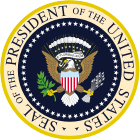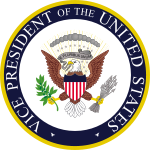Abigail Adams
| Abigail Adams | |
.jpg) Abigail Adams, later in life, by Gilbert Stuart. |
|
|
2nd First Lady of the United States
|
|
| In office March 4, 1797 – March 4, 1801 |
|
| Preceded by | Martha Washington |
|---|---|
| Succeeded by | Martha Jefferson Randolph |
|
1st Second Lady of the United States
|
|
| In office May 16, 1789 – March 4, 1797 |
|
| Preceded by | None |
| Succeeded by | Martha Jefferson Randolph |
|
|
|
| Born | November 11, 1744 Weymouth, Province of Massachusetts Bay |
| Died | October 28, 1818 (aged 73) Quincy, Massachusetts, U.S.A. |
| Spouse(s) | John Adams |
| Relations | William and Elizabeth Quincy Smith |
| Children | Abigail "Nabby", John Quincy, Susanna, Charles, Thomas, Elizabeth (stillborn) |
| Occupation | First Lady of the United States |
| Religion | Congregational |
| Signature | |
Abigail Adams (née Smith; November 11, 1744 – October 28, 1818) was the wife of John Adams, who was the second President of the United States, and the mother of John Quincy Adams, the sixth. She was the first Second Lady of the United States, and the second First Lady of the United States.
Adams is remembered for the many letters she wrote to her husband while he stayed in Philadelphia, Pennsylvania, during the Continental Congresses. John frequently sought the advice of Abigail on many matters, and their letters are filled with intellectual discussions on government and politics. The letters are invaluable eyewitness accounts of the Revolutionary War home front as well as excellent sources of political commentary.
Contents |
Early life and family
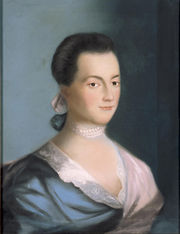
Adams was born in the North Parish Congregational Church in Weymouth, Massachusetts, on November 11, 1744, to the Rev. William Smith and Elizabeth (née Quincy) Smith. On her mother's side she was descended from the Quincy family, a well-known political family in the Massachusetts colony. Through her mother she was a cousin of Dorothy Quincy, wife of John Hancock. Adams was also the great-granddaughter of the Rev. John Norton, founding pastor of Old Ship Church in Hingham, Massachusetts, the only remaining 17th-century Puritan meetinghouse in Massachusetts.
Her father, William Smith (1707–1783), a liberal Congregationalist, and other forebears were Congregational ministers, and leaders in a society that held its clergy in high esteem. However, he did not preach about predestination, original sin or the full divinity of Christ; instead he emphasized the importance of reason and morality.[1] Adams was a sickly child and was not considered healthy enough for formal schooling. Although she did not receive a formal education, her mother taught her and her sisters Mary (1739–1811) and Elizabeth (1742–1816, known as Betsy) to read, write and cipher; her father's, uncle's and grandfather's large libraries enabled the sisters to study English and French literature.[1] As an intellectually open-minded woman for her day, Adams' ideas on women's rights and government would eventually play a major role, albeit indirectly, in the founding of the United States. She became one of the most erudite women ever to serve as First Lady.
Marriage and children
As third cousins[2], Abigail and John had known each other since they were children. In 1762 John accompanied his friend Richard Cranch to the Smith household. Cranch was engaged to Adams' older sister Mary. John was quickly attracted to the petite, shy, 17-year-old brunette who was forever bent over some book. He was surprised to learn that she knew so much about poetry, philosophy and politics, considered inappropriate reading for a woman at the time.
Although Adam's father approved of the match, her mother was appalled that her daughter would throw her life away on a country lawyer whose manners still reeked of the farm; eventually she gave in. They married on October 25, 1764, just five days before John's 29th birthday, in the Smiths' home in Weymouth. Abigail wore a square-necked gown of white challis while John appeared in a dark blue coat, contrasting light breeches and white stockings, a gold-embroidered satin waistcoat his mother had made for the occasion, and buckle shoes. Then Rev. Smith (the bride's father) performed the nuptials.
After the reception, the couple mounted a single horse and rode off to their new home, the small cottage and farm that John had inherited from his father in Braintree, Massachusetts (later renamed Quincy), before moving to Boston, where his law practice expanded.
In 10 years she gave birth to six children:
- Abigail ("Nabby") (1765–1813)
- John Quincy Adams (1767–1848)
- Susanna Boylston (1768–1770)
- Charles (1770–1800)
- Thomas Boylston Adams (1772–1832)
- Elizabeth (stillborn in 1777)
Adams looked after family and home when John went traveling as circuit judge. "Alas!" she wrote in December 1773, "How many snow banks divide thee and me...."
In 1784 she and her daughter Nabby joined her husband and her eldest son, John Quincy, at her husband's diplomatic post in Paris. After 1785 she filled the role of wife of the first U.S. minister to the Kingdom of Great Britain. They returned in 1788 to a house known as the "Old House" in Quincy, which she set about vigorously enlarging and remodeling. It is still standing and open to the public as part of Adams National Historical Park. Nabby later died of breast cancer, having endured three years of severe pain.
Abigail raised her two younger sons throughout John's prolonged absences; she also raised her elder grandchildren, including George Washington Adams and a younger John Adams, while John Quincy Adams was minister to Russia. Her childrearing included relentless and continual reminders of what the children owed to virtue and the Adams tradition.[3]
First Lady
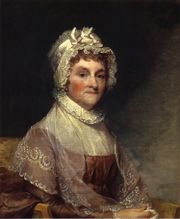
When John was elected President of the United States, Abigail continued a formal pattern of entertaining. With the removal of the capital to Washington in 1800, she became the first First Lady to preside over the White House, or President's House as it was then known. The city was wilderness, the President's House far from completion. She found the unfinished mansion in Washington "habitable" and the location "beautiful"; but she complained that, despite the thick woods nearby, she could find no one willing to chop and haul firewood for the First Family. Adams' health, never robust, suffered in Washington. She took an active role in politics and policy, unlike the quiet presence of Martha Washington. She was so politically active that her political opponents came to refer to her as "Mrs. President".
After John's defeat in his presidential re-election campaign, the family retired to Quincy in 1800. Abigail followed her son's political career earnestly, as her letters to her contemporaries show. In later years, she renewed correspondence with Thomas Jefferson, whose political opposition to her husband had hurt her deeply.
Abigail and John's marriage is well documented through their correspondence and other writings. Letters exchanged throughout John's political obligations indicate that his trust in Abigail's knowledge was sincere. "She could quote poetry more readily than could John Adams," states McCullogh. Their correspondence illuminated their mutual emotional and intellectual respect. John often excused himself to Abigail for his "vanity" (see McCullough's John Adams p. 272), exposing his need for her approval.
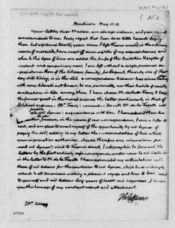
Death
Adams died on October 28, 1818, of typhoid fever, several years before her son became president. She is buried beside her husband in a crypt located in the United First Parish Church (also known as the Church of the Presidents) in Quincy, Massachusetts. She was 73 years old, exactly two weeks shy of her 74th birthday.
Her last words were, "Do not grieve, my friend, my dearest friend. I am ready to go. And John, it will not be long."
Political viewpoints
Women's rights
Adams was an advocate of married women's property rights and more opportunities for women, particularly in the field of education. Women, she believed, should not submit to laws not made in their interest, nor should they be content with the simple role of being companions to their husbands. They should educate themselves and thus be recognized for their intellectual capabilities, so they could guide and influence the lives of their children and husbands. She is known for her March 1776 letter to John and the Continental Congress, requesting that they, "...remember the ladies, and be more generous and favorable to them than your ancestors. Do not put such unlimited power into the hands of the Husbands. Remember all Men would be tyrants if they could. If particular care and attention is not paid to the Ladies we are determined to foment a Rebellion, and will not hold ourselves bound by any Laws in which we have no voice, or Representation.[1]
Unfortunately, John declined Abigail's "extraordinary code of laws," but acknowledged to Abigail, "We have only the name of masters, and rather than give up this, which would completely subject us to the despotism of the petticoat, I hope General Washington and all our brave heroes would fight."[4]
Slavery
Along with her husband, Adams believed that slavery was evil and a threat to the American democratic experiment. A letter written by her on March 31, 1776, explained that she doubted most of the Virginians had such "passion for Liberty" as they claimed they did, since they "deprive[d] their fellow Creatures" of freedom.[1]
A notable incident regarding this happened in Philadelphia in 1791, where a free black youth came to her house asking to be taught how to write. Subsequently, she placed the boy in a local evening school, though not without objections from a neighbor. Adams responded that he was "a Freeman as much as any of the young Men and merely because his Face is Black, is he to be denied instruction? How is he to be qualified to procure a livelihood? ... I have not thought it any disgrace to my self to take him into my parlor and teach him both to read and write."
Religious beliefs
Adams, as well as her husband, was an active member of the First Parish Church in Quincy, which became Unitarian in doctrine by 1753. In a letter to John Quincy Adams dated May 5, 1816, she wrote of her religious beliefs:
- I acknowledge myself a unitarian—Believing that the Father alone, is the supreme God, and that Jesus Christ derived his Being, and all his powers and honors from the Father ... There is not any reasoning which can convince me, contrary to my senses, that three is one, and one three.[1]
She also asked Louisa Adams in a letter dated January 3, 1818, "When will Mankind be convinced that true Religion is from the Heart, between Man and his creator, and not the imposition of Man or creeds and tests?"
Legacy
Memorials
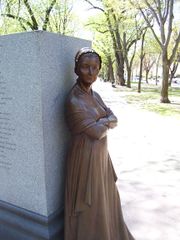
A cairn — a mound of rough stones — crowns the nearby Penn Hill from which she and her son, John Quincy, watched the Battle of Bunker Hill and the burning of Charlestown. At that time she was minding the children of Dr. Joseph Warren, president of the Massachusetts Provincial Congress, who was killed in the battle.
An Adams Memorial has been proposed in Washington, D.C., honoring Adams, her husband and other members of their family.
Popular culture
Passages from Adams' letters to her husband figured prominently in songs from the Broadway musical 1776.[1] Virginia Vestoff played Adams in the original 1969 Broadway production of 1776 and recreated the role for the film version in 1972. On television, Kathryn Walker and Leora Dana in the 1976 PBS mini-series The Adams Chronicles. In the mini-series John Adams, which premiered in March 2008 on HBO, she was played by Laura Linney. Linney enjoyed portraying Adams, saying that "she is a woman of both passion and principle."[3]
Portrait on currency
The First Spouse Program under the Presidential $1 Coin Act authorizes the United States Mint to issue half-ounce $10 gold coins and bronze medal duplicates[5] to honor the first spouses of the United States. The Abigail Adams coin was released on June 19, 2007, and sold out in just hours. She is pictured on the back of the coin writing her most famous letter to John Adams. In February 2009 Coin World reported that some 2007 Abigail Adams medals were struck using the reverse from the 2008 Louisa Adams medal, apparently by mistake.[6] These pieces, called mules, were contained within the 2007 First Spouse medal set.[6] The U.S. Mint has not released an estimate of how many mules were made.
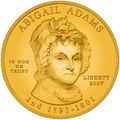 Obverse |
 Reverse |
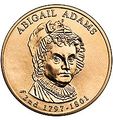 Obverse (bronze medal) |
 Reverse (bronze medal) |
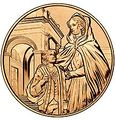 Mule Reverse (bronze medal) |
Ancestry
Abigail Adams counted among her ancestors the leaders of the Congregationalist church in the Massachusetts colony and the prominent Quincy family. Through the latter she was a descendant of the House of Beaufort, an illegitimate branch of the English House of Plantagenet, making her a distant cousin to King George III, who was King of the United Kingdom during the American Revolution.
| Ancestors of Abigail Adams | ||||||||||||||||||||||||||||||||||||||||||||||||||||||||||||||||||||||||||||||||||||||||||||||||||||||||||||||||||||||||||||||||||||||||||||||||||||||||||||||||||||||||||||||||||||||||||||||||||||||||||||||||||||||||||||||||||||||||||||||||||||||||||||||||||||||||||||||||||||||||||||||||||||||||||||||||||||||||||||||||||||||||||||||||||||||||||||||||||||||||||||||||||||||||||||||||||||||||||
|---|---|---|---|---|---|---|---|---|---|---|---|---|---|---|---|---|---|---|---|---|---|---|---|---|---|---|---|---|---|---|---|---|---|---|---|---|---|---|---|---|---|---|---|---|---|---|---|---|---|---|---|---|---|---|---|---|---|---|---|---|---|---|---|---|---|---|---|---|---|---|---|---|---|---|---|---|---|---|---|---|---|---|---|---|---|---|---|---|---|---|---|---|---|---|---|---|---|---|---|---|---|---|---|---|---|---|---|---|---|---|---|---|---|---|---|---|---|---|---|---|---|---|---|---|---|---|---|---|---|---|---|---|---|---|---|---|---|---|---|---|---|---|---|---|---|---|---|---|---|---|---|---|---|---|---|---|---|---|---|---|---|---|---|---|---|---|---|---|---|---|---|---|---|---|---|---|---|---|---|---|---|---|---|---|---|---|---|---|---|---|---|---|---|---|---|---|---|---|---|---|---|---|---|---|---|---|---|---|---|---|---|---|---|---|---|---|---|---|---|---|---|---|---|---|---|---|---|---|---|---|---|---|---|---|---|---|---|---|---|---|---|---|---|---|---|---|---|---|---|---|---|---|---|---|---|---|---|---|---|---|---|---|---|---|---|---|---|---|---|---|---|---|---|---|---|---|---|---|---|---|---|---|---|---|---|---|---|---|---|---|---|---|---|---|---|---|---|---|---|---|---|---|---|---|---|---|---|---|---|---|---|---|---|---|---|---|---|---|---|---|---|---|---|---|---|---|---|---|---|---|---|---|---|---|---|---|---|---|---|---|---|---|---|---|---|---|---|---|---|---|---|---|---|---|---|---|---|---|---|---|---|---|---|---|---|---|---|---|---|---|---|---|---|---|---|---|---|---|---|---|---|---|---|---|---|---|---|---|---|---|---|---|---|---|
|
||||||||||||||||||||||||||||||||||||||||||||||||||||||||||||||||||||||||||||||||||||||||||||||||||||||||||||||||||||||||||||||||||||||||||||||||||||||||||||||||||||||||||||||||||||||||||||||||||||||||||||||||||||||||||||||||||||||||||||||||||||||||||||||||||||||||||||||||||||||||||||||||||||||||||||||||||||||||||||||||||||||||||||||||||||||||||||||||||||||||||||||||||||||||||||||||||||||||||
References
- ↑ 1.0 1.1 1.2 1.3 1.4 1.5 Abigail Adams
- ↑ This Day in History in 1828, www.history.com, retrieved 3-13-2008
- ↑ 3.0 3.1 Garry Wills, Henry Adams and the Making of America, 2005; p. 24; Wills cites the criticisms of Paul Nagel "and others"
- ↑ The exchange can be found online here.
- ↑ U.S. Mint: First Spouse Program. Accessed 2008-06-27. "The United States Mint also produces and make available to the public bronze medal duplicates of the First Spouse Gold Coins."
- ↑ 6.0 6.1 Gilkes, Paul (2009-02-16). "First Spouse medals set holds Adams mule". Coin World 50 (2549): 1. "Some collectors have begun receiving a First Spouse medal mule - a piece bearing the obverse for Abigail Adams and a reverse intended for the Louisa Adams medal. The mules surfaced in some of the 2007 First Spouse sets...".
Bibliography
- Nagel, Paul C. 1987. The Adams Women: Abigail and Louisa Adams, Their Sisters and Daughters. New York: {Oxford University Press}. ISBN 0195038746
- Bober, Natalie S. 1995. Abigail Adams: Witness to a revolution New York: Simon & Schuster Children's Publishing Division.
External links
- Short summary of Abigail's Life
 "Adams, Abigail". Appletons' Cyclopædia of American Biography. 1900.
"Adams, Abigail". Appletons' Cyclopædia of American Biography. 1900.- Adams family biographies - Massachusetts Historical Society
- Collection of Abigail Adams Letters
- My Dearest Friend: Letters of Abigail and John Adams, Harvard University Press
- The Adams Women: Abigail and Louisa Adams, Their Sisters and Daughters, Harvard University Press
- Descent from Glory: Four Generations of the John Adams Family, Harvard University Press
- Adams Family Correspondence. Cambridge: Harvard University Press
- Abigail Adams Birthplace - Museum in Weymouth, Massachusetts
- Ancestors of Abigail Smith
- "Abigail Adams". Find a Grave. http://www.findagrave.com/cgi-bin/fg.cgi?page=gr&GRid=4. Retrieved August 5, 2010.
| Honorary titles | ||
|---|---|---|
| Preceded by New Title |
Second Lady of the United States 1789–1797 |
Succeeded by Ann Gerry |
| Preceded by Martha Dandridge Custis Washington |
First Lady of the United States 1797–1801 |
Succeeded by Martha Jefferson Randolph |
|
|||||||
|
|||||||
